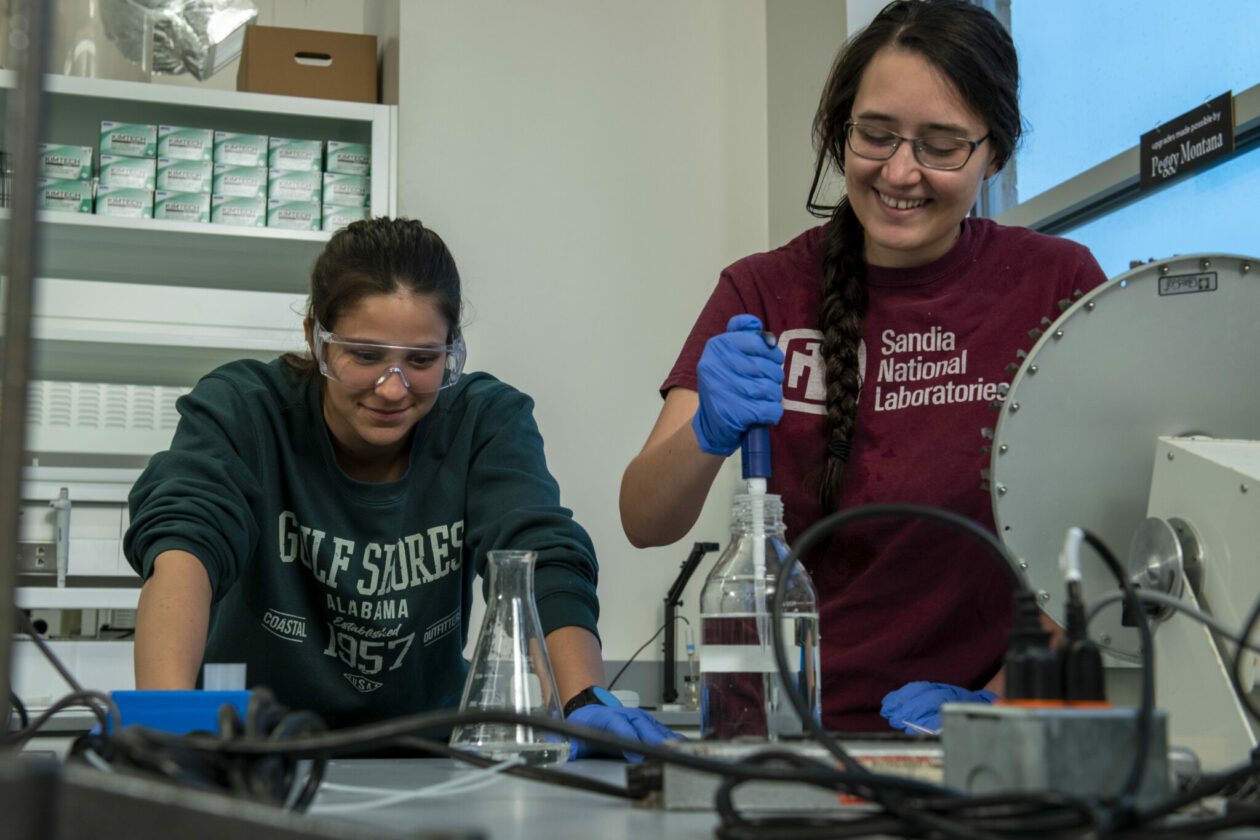UM Board of Curators approves Missouri S&T biomedical engineering program
Posted by Greg Edwards

Brittney Hahn, left, and Tatianna Reinbolt working in the Kielhorn Laboratory Suite inside Bertelsmeyer Hall when they were studying biochemical engineering at S&T. Both women are now S&T alumnae. Photo by Michael Pierce/Missouri S&T.
Missouri S&T has long been home to some of the world’s leading biomedical engineering researchers, and the university is now on track to launch a new bachelor’s degree program in this field.
“This degree will allow us to train the engineering workforce of the future at the intersection of engineering and medicine,” says Dr. David Borrok, vice provost and dean of S&T’s College of Engineering and Computing. “Prospective students are highly interested in this field, and we have a critical mass of the faculty expertise and resources necessary to provide them with a top-tier education.”
The University of Missouri Board of Curators unanimously voted today (Sept. 7) to approve the new program. The next step will be for the Missouri Coordinating Board for Higher Education (CBHE) to review S&T’s proposal. Pending CBHE approval, the university aims to admit students into this new major starting in fall 2024.
Labor market analytics show the demand for biomedical engineering professionals in Missouri will increase by 18% over the next decade. Dr. Hu Yang, the Linda and Bipin Doshi Chair of Chemical and Biochemical Engineering at S&T, says S&T’s future alumni for this program will be well-prepared to focus on a variety of biomedical-related issues. The new program will be housed in Yang’s department.
Potential career paths will include everything from pharmaceutical research to developing medical devices and prosthetics. Tissue engineering and researching potential organ repair and replacement methods are other possible areas of focus. Students will also be well-prepared to earn advanced degrees in related areas, such as medicine, he says.
“Our graduates will be in high demand,” Yang says. “Many of our department’s students have already gone on to have fantastic careers related to biomedical engineering, and I am hopeful that we will soon have an even more comprehensive program in this area to offer. The education they receive will prepare them to truly help shape the future of medicine.”
Yang is one of S&T’s biomedical researchers who is internationally renowned for his work. He is pioneering a new glaucoma treatment involving nanotechnology and was awarded a R01 grant from the National Institutes of Health for his efforts.
Other notable biomedical researchers affiliated with S&T include Dr. Delbert Day, whose work with radioactive glass microspheres has transformed cancer treatment methods, and Dr. Richard Brow, who has also helped shape how glass developed for biomedical applications is researched and applied. Day is a Curators’ Distinguished Professor emeritus of materials science and engineering at S&T and a member of the National Academy of Engineering, while Brow is a Curators’ Distinguished Professor of ceramic engineering and special assistant to the provost for academics.
In addition, Dr. Mark Towler, Doshi Professor of Chemical and Biochemical Engineering at S&T, invented a diagnostic device that can indicate a person’s risk of bone fracture by analyzing their nail clipping. He holds eight patents in the medical devices space and is now researching the field of orthopedics and trauma surgery. Dr. Anthony Convertine, a Roberta and G. Robert Couch Assistant Professor of Materials Science and Engineering at S&T, is researching methods for using nanomaterials to 3D-print human tissue, with the goal of eventually printing organs.
Other S&T researchers are focusing on new treatments for wound care patients and developing diagnostic instruments that are more readily available and simpler for doctors and patients to use.
“We have an amazing group of faculty across the S&T campus who have made significant contributions in the biomedical arena,” Yang says. “It is only logical to pull these efforts together and have a new biomedical engineering program for our students.”
Leaders from multiple organizations, such as Pfizer, Curium Pharma, Emerson and DeNovix Inc., among several others, submitted letters supporting S&T’s proposal to the UM Board of Curators.
“Missouri S&T’s reputation for excellence in engineering education and research, combined with its strategic location in the heart of the Midwest, makes it an ideal institution to develop such a program,” says Justin Sperry, Pfizer’s vice president of transformational technology and the Chesterfield, Missouri, site head. “The university’s proximity to major biomanufacturing and biomedical hubs will enable students to engage in cutting-edge research and gain valuable industry experience through internships and co-op opportunities.
“This, in turn, will help build a strong talent pipeline to support continued growth and innovation in the biopharmaceutical and biomedical sectors.”
The Missouri S&T College of Engineering and Computing is home to more than 4,200 undergraduate students and approximately 800 graduate students on campus. S&T is the top public institution for engineering programs in the state, according to U.S. News and World Report rankings.
To learn more about the college and its programs, visit cec.mst.edu.
About Missouri S&T
Missouri University of Science and Technology (Missouri S&T) is a STEM-focused research university of over 7,000 students. Part of the four-campus University of Missouri System and located in Rolla, Missouri, Missouri S&T offers 101 degrees in 40 areas of study and is among the nation’s top 10 universities for return on investment, according to Business Insider. For more information about Missouri S&T, visit www.mst.edu.
Leave a Reply